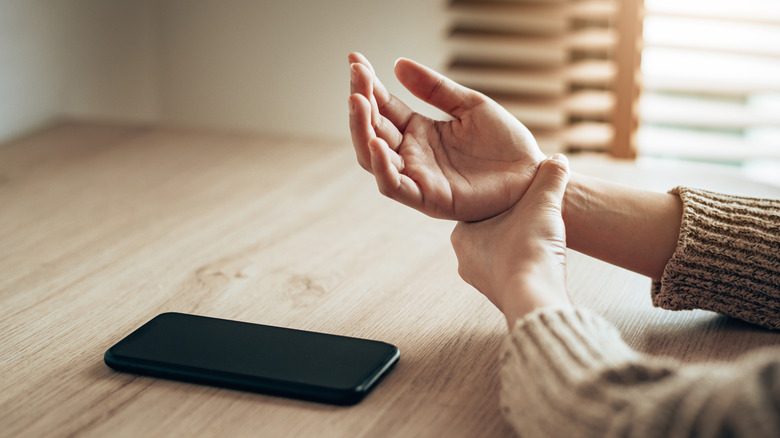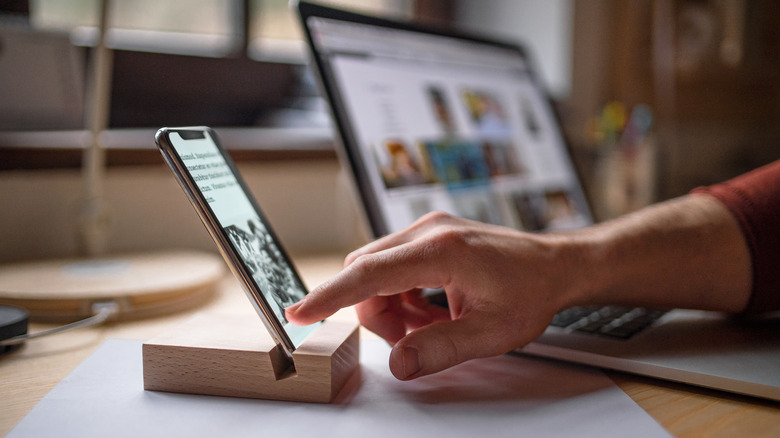What Does It Mean When Your Wrist Hurts After Using A Phone?
Smartphones are an integral part of the modern lifestyle, making it easier to shop, chat, and work on the go. Unfortunately, these benefits come with tradeoffs, such as eye strain, headaches, and the fear of missing out (FOMO). For example, South University reports that smartphone users are more likely to develop staph infections and engage in distracted driving. Plus, they are at higher risk for vision problems resulting from too much screen time. Another common problem is the fear of missing out, an all-consuming feeling that can affect sleep, mental well-being, work or school performance, and overall mood, according to recent research published in Frontiers in Psychiatry.
Handheld devices, including mobile phones, can also hurt your wrist, elbow, or neck in the long run. Common health complaints, such as the so-called "cell phone neck" and "smartphone thumb" aka texting tendinitis, often result from the repetitive motions associated with smartphone use. "You see a lot of neck pain in patients that is more repetitive in nature than traumatic, like from a car accident," physical therapist Jason Hutchison told Franciscan Health. Over time, smartphone usage can lead to neurological problems, back pain, chronic headaches, carpal tunnel syndrome, and other conditions or injuries.
But why does your wrist hurt after using a phone — and should you be concerned about it? Let's find out.
Excessive smartphone use can cause wrist injuries
Texting, online shopping, photo editing, and other smartphone activities involve repetitive motions of hand and arm. These micro-movements can put stress on your tendons, ligaments, bones, and muscles, causing all sorts of aches. "For some, the repetitive motion can lead to conditions like cubital tunnel or carpal tunnel syndromes, de Quervain's tenosynovitis, tendinitis, and even arthritis," says orthopedic hand surgeon Tanay Amin told Banner Health.
For example, a 2020 study conducted on 387 students found that more than 66% were addicted to their smartphones and 19% had De Quervain tenosynovitis, a condition characterized by thumb and wrist pain, per Medicine. As the researchers note, there's a growing body of evidence to suggest that mobile texting can affect the wrist and thumbs. These problems are becoming increasingly common among teenagers, affecting as many as 43% of those who overuse their smartphones.
Another injury related to smartphone use is tendonitis, according to Piedmont Healthcare. This inflammatory condition causes pain in the wrist and fingers, limiting your range of motion. "It is the sheer volume of these repetitive motions that are leading to the onset of tendonitis," explains hand and orthopedic surgeon Virginia Jones. What's more, excessive smartphone use can worsen arthritis pain and exasperate the forearm tendons, warns the American Academy of Orthopaedic Surgeons.
Take these steps to prevent and relieve wrist pain
Most Americans spend over 4 hours per day on mobile devices, reports CNET. Unfortunately, this habit can lead to painful injuries that may require months of treatment. The most obvious solution would be to stop using your smartphone or tablet for a couple of weeks, but that's not really possible in this digital age. One thing you can do to prevent wrist pain is to take frequent breaks from your device, suggests Franciscan Health. Stretch your wrist, fingers, neck, and chest several times a day to relieve tension.
Dr. Tanay Amin recommends placing your phone on a flat surface instead of holding it in your hands, per Banner Health. Another option is to use an adjustable phone stand along with a stylus or hands-free accessories like headsets and earbuds. You may also try voice typing, a feature available on most smartphones and tablets, per Franciscan Health. Remember to switch hands regularly and avoid using the same finger(s) every time you type on your device.
If you already have pain in your wrist, consider wearing an orthotic splint until your symptoms improve, suggests Dr. Armin. However, tendinitis and other overuse injuries affecting the wrist may require medical treatment and can take months to heal. "First and foremost, if you are experiencing any pain, numbness, tingling, or stiffness that persists more than two weeks or interferes with your daily life, it's important to not wait to see your doctor," says Dr. Amin.


